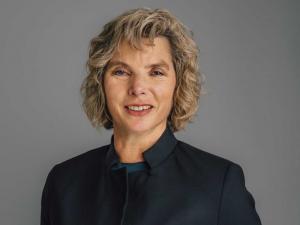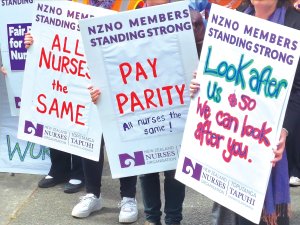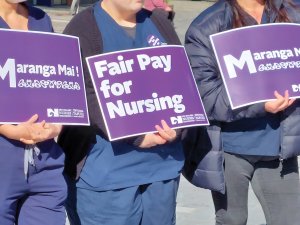Respiratory physician Lutz Beckert considers chronic obstructive pulmonary disease management, including the prevention of COPD, the importance of smoking cessation and pulmonary rehabilitation, and the lifesaving potential of addressing treatable traits. He also discusses the logic of inhaler therapy, moving from single therapy to dual and triple therapy when indicated, as well as other aspects of management
Pay ‘bump’ omits primary care, hospitals poaching practice nurses
Pay ‘bump’ omits primary care, hospitals poaching practice nurses

The funding will not result in the same pay or working conditions [as] Te Whatu Ora employed nurses. That is not its intention
General practice may get some pay “disparities” funding for nurses from 1 July but this is not aimed at matching yesterday’s historic pay increase for public hospital nurses, says health minister Ayesha Verrall.
Dr Verrall today indicated via email that general practice may be eligible from 1 July for the “pay disparities initiative” fund announced last November.
But she said the funding package was not intended to fund eligible community and primary health employers to match Te Whatu Ora nurses’ new pay rates.
Yesterday, Dr Verrall put out a media release to mark a $540 million pay equity settlement being rolled out to Te Whatu Ora nurses this month, with most registered nurses in hospitals receiving an increase of $12,000, or 14 per cent.
General Practice Owners Association chief executive Philip Grant says the growing pay gap (now 22 to 27 per cent) between practice nurses and Te Whatu Ora nurses is creating “huge challenges” for recruitment and retention.
“Our member survey in late 2022 found that nearly half (46 per cent) of family doctor services had lost at least one nurse in the previous three months and half of all practices had a current vacancy for one or more nurses,” says Mr Grant in a media release.
He says advocating for pay parity and pay equity is GenPro’s key focus.
General practices were controversially excluded from the first tranche of the $200 million-a-year fund that had been touted by then health minister Andrew Little to “take action on pay parity in the health sector”.
New minister Dr Verrall and Te Whatu Ora national commissioning director Abbe Anderson describe the funding package as being for “pay disparity” and to “reduce pay gaps” rather than “pay parity”. (Pay parity is considered by the general practice sector as matching the base pay rate that practice nurses would receive if working for Te Whatu Ora.)
In today’s response, Dr Verrall acknowledged that general practice nurses had been initially excluded from the funding package based on advice “at the time that no disparity existed”.
Dr Verrall says she has now asked Te Whatu Ora to work with other funded sectors, including primary care (general practices), rural hospitals, telehealth, Family Planning, school nursing services, Plunket and mental health and addition, to see whether “disparities in pay exist”.
“If disparities are found, Te Whatu Ora will advise myself and the minister of finance and we could make funding available from 1 July 2023 for the primary care sector.”
This was later confirmed to mean funding from the existing package, which she described as a significant investment to reduce pay gaps.
But, she says, “it will not result in the same pay or working conditions [as] Te Whatu Ora employed nurses”.
“That is not its intention.”
READ MORE:
- New chair appointed, pay parity discussed at general practice forum
- General practice ‘needs to be included’ in pay parity, Te Whatu Ora official says
- Relationships key for Verrall: General practice ‘incredibly important’ to reforms
- Pay parity funding inconsistent: Official information fails to clarify why practice nurses left out
The GenPro survey, responded to by 185 practices, found nurses were leaving general practice for better-paid hospital jobs, relocating locally or internationally, or exiting primary care due to stress and heavy workloads, says Mr Grant in the release.
“More than half of our practices (53 per cent) have reduced service levels due to the workforce shortages and a significant number (36.5 per cent) have completely withdrawn some services altogether.”
Devon Medical Centre director Pat Leary is quoted as saying his practice has lost two nurses since the start of the year as they could get paid more elsewhere.
From this month, there is a $20,000 pay gap between what an experienced practice nurse can earn under the existing main primary care pay deal and the base pay they could earn at Te Whatu Ora.
Dr Verrall says the providers eligible for the first tranche of the funding package, the $40 million announced in November for the year ending 30 June, would start to receive additional funding from early April.
The sectors eligible for funding to lift their nurse and kaiawhina pay rates are aged residential care, hospices, home and community support services, and Māori and Pacific healthcare providers.
The New Zealand Aged Care Association has said its sector’s share of the fund is less than half of what is required.
Association deputy chair Warick Dunn tells New Zealand Doctor, Te Whatu Ora has allocated $20.1 million for aged residential care nurses but the association calculated the sector needed $46 million this financial year.
He says the $46 million estimate is to match the new Te Whatu Ora interim pay equity rates that came into effect this month, adding an extra 14 per cent gap.
Residential aged care sector has more than 1000 vacancies and has already closed 1200 aged care beds due to the severe shortage of registered nurses, which is putting additional pressure on Te Whatu Ora hospitals, he says.
“For us to draw back or retain registered nurses, it is crucial that providers are funded to match the Te Whatu Ora rates,” Mr Dunn says.
He called on the Government to fund pay parity for the sector or face more vulnerable elderly people being displaced or stuck in public hospitals because of the lack of aged residential care beds.
Mr Little’s initial pay parity package announcement on 28 November 2022 provided the following definitions:
-
Pay equity is a process of ensuring men and women get the same pay for doing jobs that are different but of equal value and with similar levels of skill and responsibility.
-
Pay parity is a process of closing the pay gap between workers doing the same job but for different organisations.
We're publishing this article as a FREE READ so it is FREE to read and EASY to share more widely. Please support us and the hard work of our journalists by clicking here and subscribing to our publication and website








![Barbara Fountain, editor of New Zealand Doctor Rata Aotearoa, and Paul Hutchison, GP and senior medical clinician at Tāmaki Health [Image: Simon Maude]](/sites/default/files/styles/thumbnail_cropped_100/public/2025-03/Barbara%20Fountain%2C%20editor%20of%20New%20Zealand%20Doctor%20Rata%20Aotearoa%2C%20and%20Paul%20Hutchison%2C%20GP%20and%20senior%20medical%20clinician%20at%20T%C4%81maki%20Health%20CR%20Simon%20Maude.jpg?itok=-HbQ1EYA)
![Lori Peters, NP and advanced health improvement practitioner at Mahitahi Hauora, and Jasper Nacilla, NP at The Terrace Medical Centre in Wellington [Image: Simon Maude]](/sites/default/files/styles/thumbnail_cropped_100/public/2025-03/2.%20Lori%20Peters%2C%20NP%20and%20advanced%20HIP%20at%20Mahitahi%20Hauora%2C%20and%20Jasper%20Nacilla%2C%20NP%20at%20The%20Terrace%20Medical%20Centre%20in%20Wellington%20CR%20Simon%20Maude.jpg?itok=sUfbsSF1)
![Ministry of Social Development health and disability coordinator Liz Williams, regional health advisors Mary Mojel and Larah Takarangi, and health and disability coordinators Rebecca Staunton and Myint Than Htut [Image: Simon Maude]](/sites/default/files/styles/thumbnail_cropped_100/public/2025-03/3.%20Ministry%20of%20Social%20Development%27s%20Liz%20Williams%2C%20Mary%20Mojel%2C%20Larah%20Takarangi%2C%20Rebecca%20Staunton%20and%20Myint%20Than%20Htut%20CR%20Simon%20Maude.jpg?itok=9ceOujzC)
![Locum GP Helen Fisher, with Te Kuiti Medical Centre NP Bridget Woodney [Image: Simon Maude]](/sites/default/files/styles/thumbnail_cropped_100/public/2025-03/4.%20Locum%20GP%20Helen%20Fisher%2C%20with%20Te%20Kuiti%20Medical%20Centre%20NP%20Bridget%20Woodney%20CR%20Simon%20Maude.jpg?itok=TJeODetm)
![Ruby Faulkner, GPEP2, with David Small, GPEP3 from The Doctors Greenmeadows in Napier [Image: Simon Maude]](/sites/default/files/styles/thumbnail_cropped_100/public/2025-03/5.%20Ruby%20Faulkner%2C%20GPEP2%2C%20with%20David%20Small%2C%20GPEP3%20from%20The%20Doctors%20Greenmeadows%20in%20Napier%20CR%20Simon%20Maude.jpg?itok=B0u4wsIs)
![Rochelle Langton and Libby Thomas, marketing advisors at the Medical Protection Society [Image: Simon Maude]](/sites/default/files/styles/thumbnail_cropped_100/public/2025-03/6.%20Rochelle%20Langton%20and%20Libby%20Thomas%2C%20marketing%20advisors%20at%20the%20Medical%20Protection%20Society%20CR%20Simon%20Maude.jpg?itok=r52_Cf74)
![Specialist GP Lucy Gibberd, medical advisor at MPS, and Zara Bolam, urgent-care specialist at The Nest Health Centre in Inglewood [Image: Simon Maude]](/sites/default/files/styles/thumbnail_cropped_100/public/2025-03/7.%20Specialist%20GP%20Lucy%20Gibberd%2C%20medical%20advisor%20at%20MPS%2C%20and%20Zara%20Bolam%2C%20urgent-care%20specialist%20at%20The%20Nest%20Health%20Centre%20in%20Inglewood%20CR%20Simon%20Maude.jpg?itok=z8eVoBU3)
![Olivia Blackmore and Trudee Sharp, NPs at Gore Health Centre, and Gaylene Hastie, NP at Queenstown Medical Centre [Image: Simon Maude]](/sites/default/files/styles/thumbnail_cropped_100/public/2025-03/8.%20Olivia%20Blackmore%20and%20Trudee%20Sharp%2C%20NPs%20at%20Gore%20Health%20Centre%2C%20and%20Gaylene%20Hastie%2C%20NP%20at%20Queenstown%20Medical%20Centre%20CR%20Simon%20Maude.jpg?itok=Z6u9d0XH)
![Mary Toloa, specialist GP at Porirua and Union Community Health Service in Wellington, Mara Coler, clinical pharmacist at Tū Ora Compass Health, and Bhavna Mistry, specialist GP at Porirua and Union Community Health Service [Image: Simon Maude]](/sites/default/files/styles/thumbnail_cropped_100/public/2025-03/9.%20Mary%20Toloa%2C%20Porirua%20and%20Union%20Community%20Health%20Service%20in%20Wellington%2C%20Mara%20Coler%2C%20T%C5%AB%20Ora%20Compass%20Health%2C%20and%20Bhavna%20Mistry%2C%20PUCHS%20CR%20Simon%20Maude.jpg?itok=kpChr0cc)